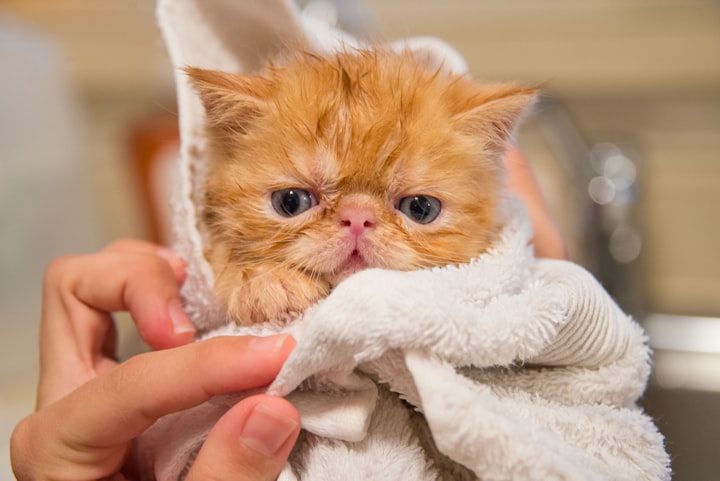Cat Chat: Decoding Your Cat's Vocalizations And Body Language
Understanding The Secret Language Of Cats: A Guide To Interpreting Your Feline Companion's Vocal And Non-Verbal Communication

As a young girl, Lily had always been fascinated by the stray cats that roamed the streets of her neighborhood. She would spend hours sitting on her front porch, watching them dart in and out of alleyways, and listening to their yowls and meows. Over time, Lily learned to recognize the different vocalizations and body language of the cats, and she even began to leave out bowls of water and food for them.
One summer day, Lily was out on her porch when she saw a small black and white cat limping down the street. The cat was dragging one of its back legs and meowing pitifully. Lily could tell that the cat was injured and needed help. She ran inside and told her parents, and they quickly gathered up a towel and a carrier.
With her parents' help, Lily coaxed the cat into the carrier, and they rushed it to the vet. The vet examined the cat and determined that it had a broken leg. They set the leg and gave the cat pain medication, and Lily's family took it home to recover.
Over the next few weeks, Lily cared for the cat, making sure it had plenty of food, water, and a comfortable place to rest. She named the cat Lucky, and she quickly became attached to it. As Lucky's leg healed, she became more playful and affectionate, and Lily knew that she couldn't bear to part with her new furry friend.
With her parents' permission, Lily took Lucky to the vet for all the necessary shots and check-ups, and she even got her a collar with a little bell. Lucky became a permanent resident of Lily's home, and the two of them formed a bond that would last a lifetime.
Years later, as Lily sat on her front porch with Lucky by her side, she thought back to the day she had first seen the injured cat limping down the street. She knew that if she hadn't taken the time to learn about cat vocalizations and body language, she might never have been able to help Lucky when she needed it most. And she was grateful for the lessons she had learned from the stray cats that had captured her heart all those years ago.

Cats are fascinating animals, and their behaviors have intrigued and puzzled humans for centuries. Whether it's their unique vocalizations or their body language, cats communicate with their owners in ways that are not always easy to understand. This article will explore some of the most common ways that cats communicate through their vocalizations and body language.
Understanding Cat Vocalizations
Cats use a variety of vocalizations to communicate with their owners, including meows, purrs, chirps, and growls. Each vocalization has a different meaning, and understanding these sounds can help you better communicate with your feline friend.
Meows: One of the most common vocalizations that cats make is the meow. Meows can mean a variety of things, from a simple greeting to a demand for attention or food. Some cats are more vocal than others, and some will meow more frequently than others. It's important to pay attention to the context of the meow to understand what your cat is trying to communicate.
Purrs: Cats also purr, which is a low, rumbling sound that they make when they're happy or content. Purring can also indicate pain or discomfort, so it's important to pay attention to other cues from your cat, such as their body language, to understand the meaning of the purr.
Chirps: Another vocalization that cats make is the chirp. Chirps are high-pitched sounds that cats use to communicate with their owners or other cats. Chirps can indicate excitement or playfulness, and they're often used as a greeting.
Growls: When cats feel threatened or aggressive, they may growl. Growls are low, guttural sounds that indicate that the cat is feeling defensive or hostile. If your cat is growling, it's important to give them space and try to remove whatever is causing them to feel threatened.

Understanding Cat Body Language
In addition to vocalizations, cats also communicate through their body language. By paying attention to your cat's posture, tail movements, and facial expressions, you can better understand what your cat is feeling and trying to communicate.
Posture: A cat's posture can tell you a lot about their mood. When a cat is relaxed and comfortable, it'll often lie down or sit with its legs tucked underneath them. When a cat is feeling threatened or defensive, it may arch its back and puff up its fur to appear larger.
Tail Movements: A cat's tail is one of the most expressive parts of its body. When a cat's tail is relaxed and held low, they're likely to feel calm and content. When a cat's tail is twitching or lashing back and forth, it may indicate that they're feeling agitated or irritated. A cat's tail can also indicate playfulness or excitement, especially when it's held high and puffed up.
Facial Expressions: Cats have a wide range of facial expressions that can indicate their mood. When a cat is feeling content or happy, their eyes will be relaxed and their pupils may be dilated. When a cat is feeling anxious or afraid, their eyes may be wide open, and their pupils may be constricted. A cat's facial expressions can also indicate aggression or playfulness, depending on the context.

10 Hidden Or Lesser-Known Facts About Cats

Here Are Some Of Them:
1. Cats have a special organ called the vomeronasal organ, also known as the Jacobson's organ, located in the roof of their mouth. This organ helps cats detect pheromones, which are chemical signals used for communication with other cats.
2. Cats have powerful night vision due to their large pupils, specialized retina, and reflective layer behind the retina called the tapetum lucidum. This allows them to see in low light conditions, making them great hunters at night.
3. Unlike dogs, cats cannot taste sweet flavors. This is due to the fact that they lack the necessary taste receptors to detect sweet taste.
4. Cats are referred to as a clowder, while kittens are referred to as a kindle.
5. Cats have a flexible spine that allows them to twist and contort their bodies in incredible ways, enabling them to squeeze through tight spaces and perform acrobatic feats.
6. Cats are able to rotate their ears 180 degrees, which helps them to pinpoint the location of sounds and detect potential prey.

7. The oldest known cat breed is the Egyptian Mau, which has been around for more than 4,000 years.
8. Ancient Egyptians worshipped cats as gods as sacred animals. They were often depicted in art and were believed to bring good luck and protection to their owners.

9. Some cats are known to have a natural resistance to the effects of certain types of venom, making them potentially useful in medical research.
10. A cat's nose pad is unique, much like a human's fingerprint. No two cats have the same nose pad pattern, making it a useful tool for identification in some situations.
Conclusion
Cats are complex animals, and understanding their vocalizations and body language can take time and patience. By paying attention to your cat's vocalizations and body language, you can better understand their needs and emotions, and build a stronger bond with your feline friend. Remember to always approach your cat with respect and kindness, and be patient as you learn to decode their unique language.
Disclaimer:
This blog contains only information that is intended to be informative. We make no representations or warranties of any kind, express or implied, about the completeness, accuracy, reliability, suitability, or availability of the information contained on the blog. Your sole responsibility for reliance on such information lies with you. I earn a commission after the product is purchased
About the Creator
Kingsley Osevwe
I'm a multi-faceted entrepreneur, coder & writer, and sought-after business coach with expertise in internet marketing, farming & passive income streams. I've built websites for businesses & trained many to earn online.






Comments
There are no comments for this story
Be the first to respond and start the conversation.